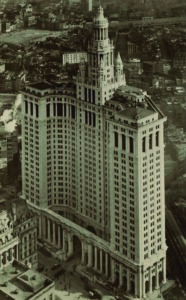
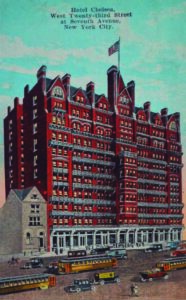
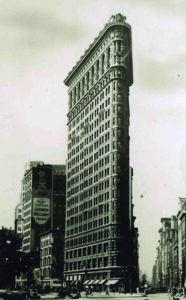
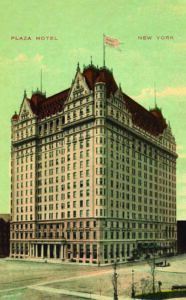
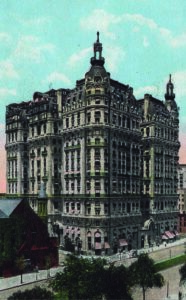
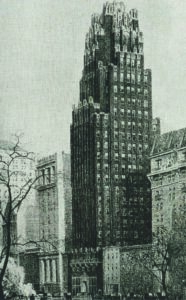
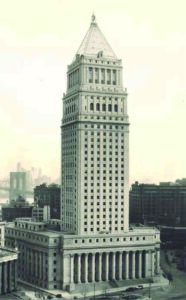
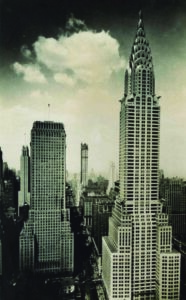
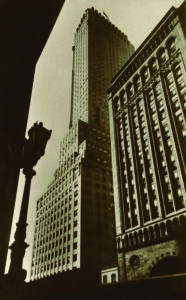
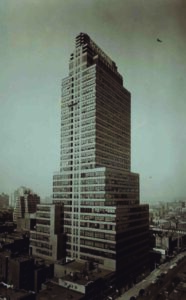
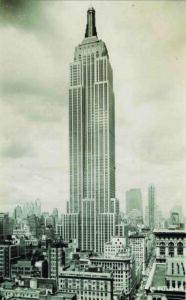
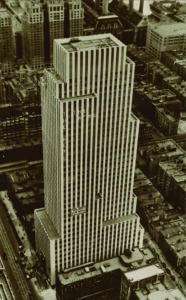
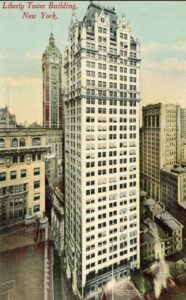
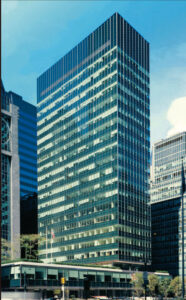
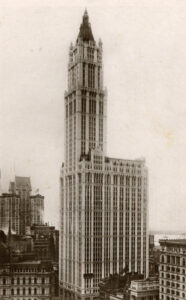
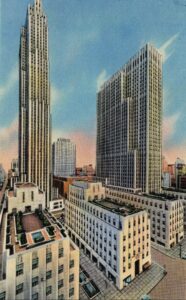
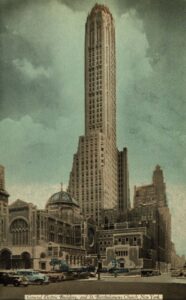
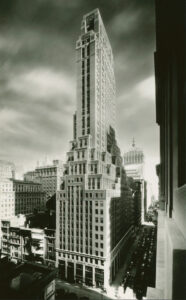
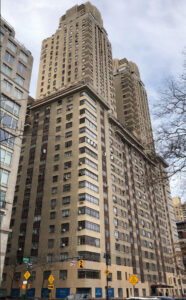
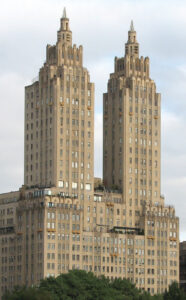
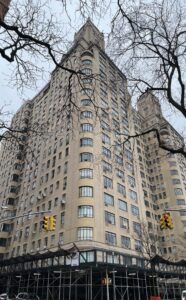
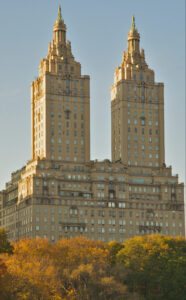
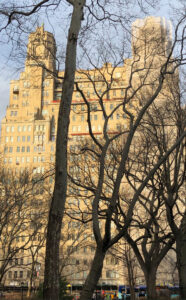
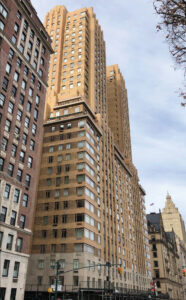
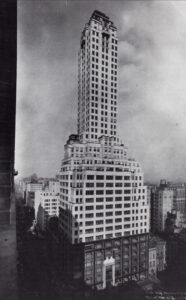
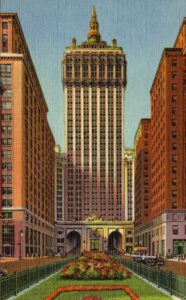
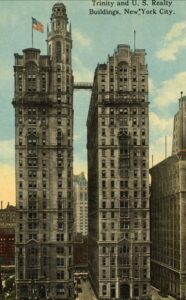
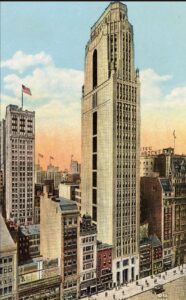
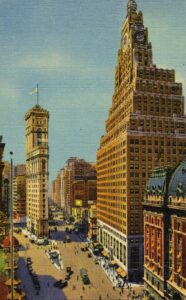
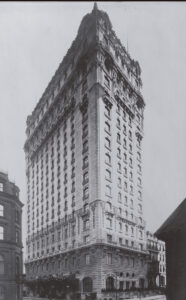
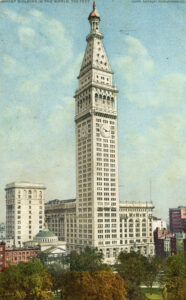
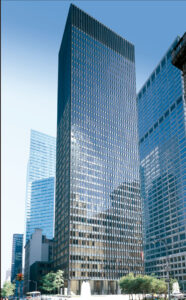
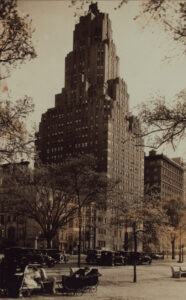
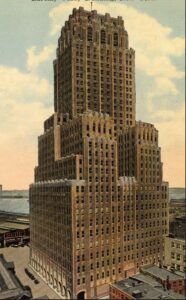
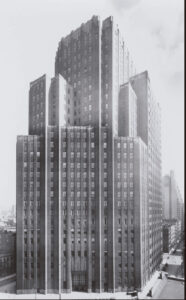
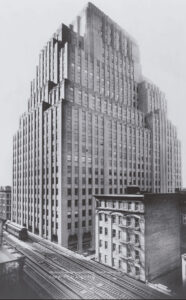
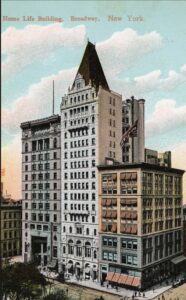
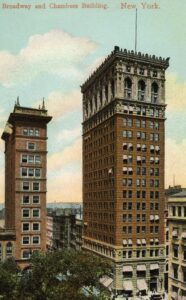
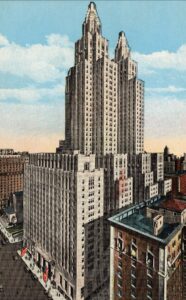
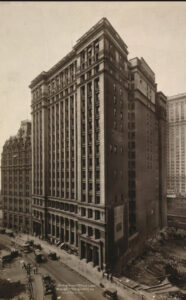
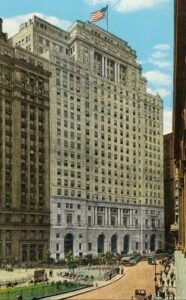
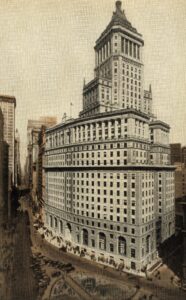
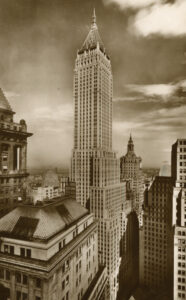
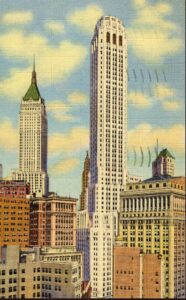
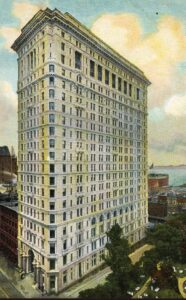
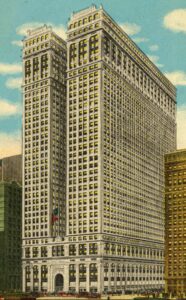
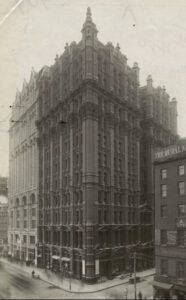
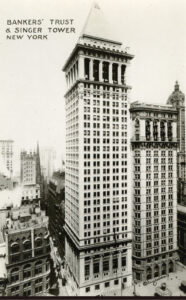
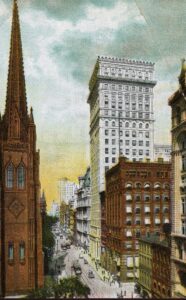
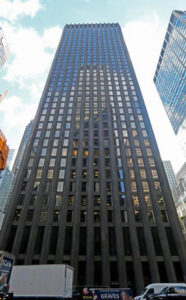
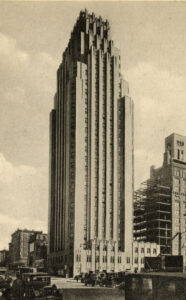
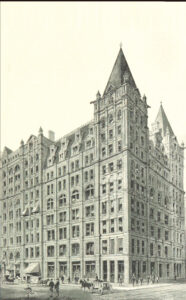
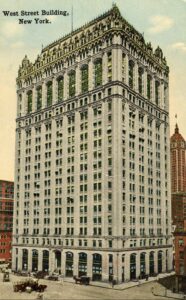
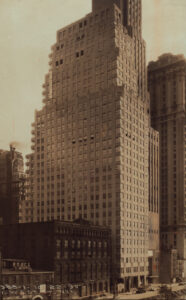
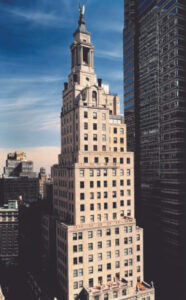
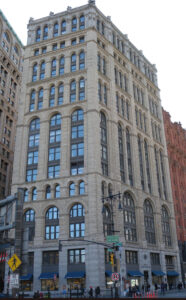
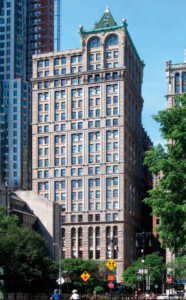
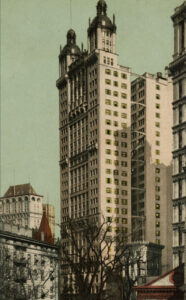
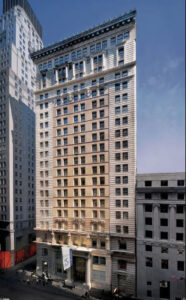
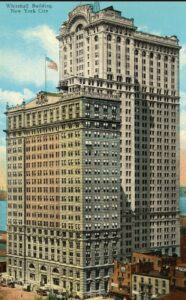
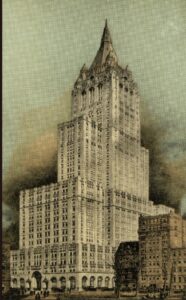
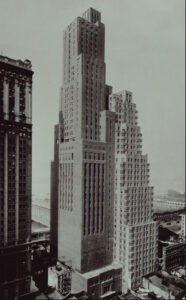
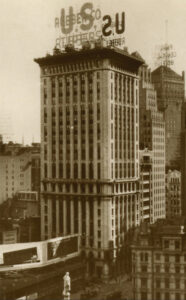
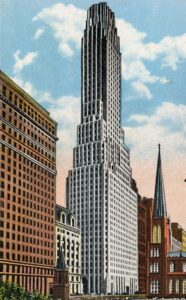
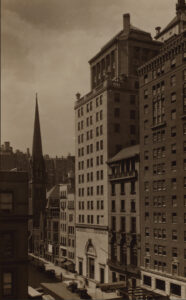
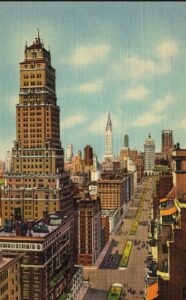
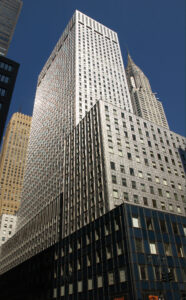
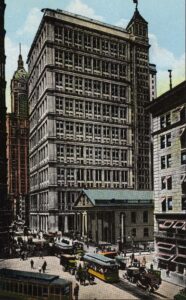
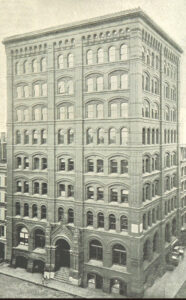
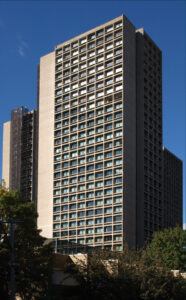
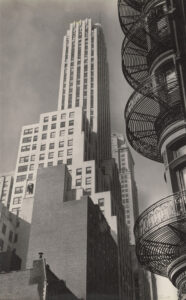
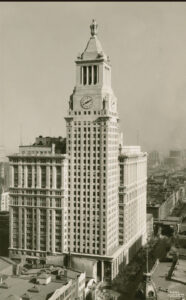
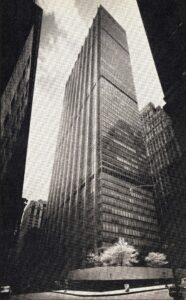
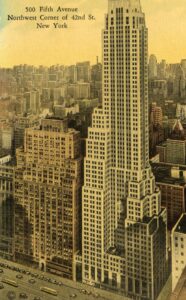
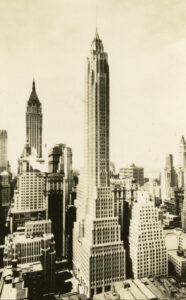
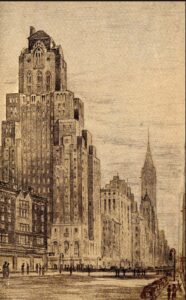
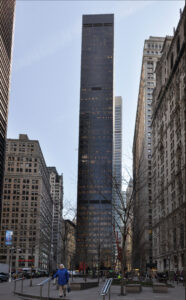
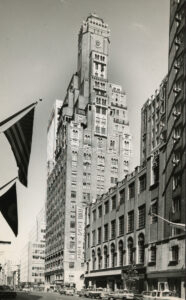
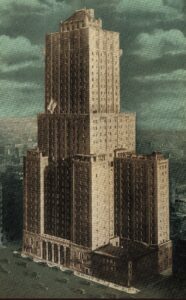
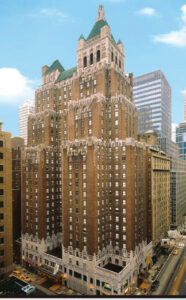
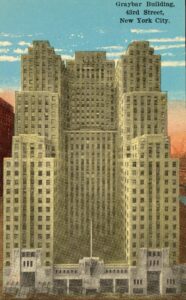
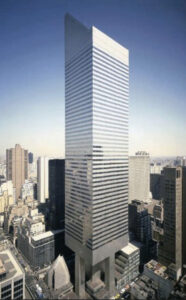
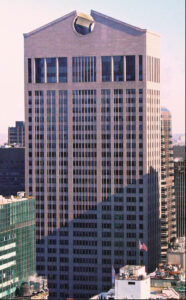
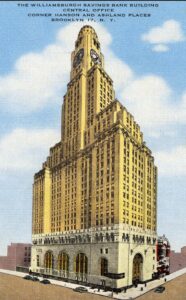
Timeline of Skyscraper Landmarks by Designation Date
This interactive Timeline presents the buildings chronologically by their designation date and identifies the name, completion date, and architect. Use the cursor to reveal these. The bands below show the administration dates of presiding Mayors and Chairs of the Landmarks Commission.
The names and basic IDs of all the buildings in the Timeline are listed at the end of this page. The IDs are color-coded to denote Downtown buildings (south of 14th St.) in red and Midtown buildings in blue. The few skyscraper Landmarks north of 59th St. are green.
1966-1974, Early Landmarks
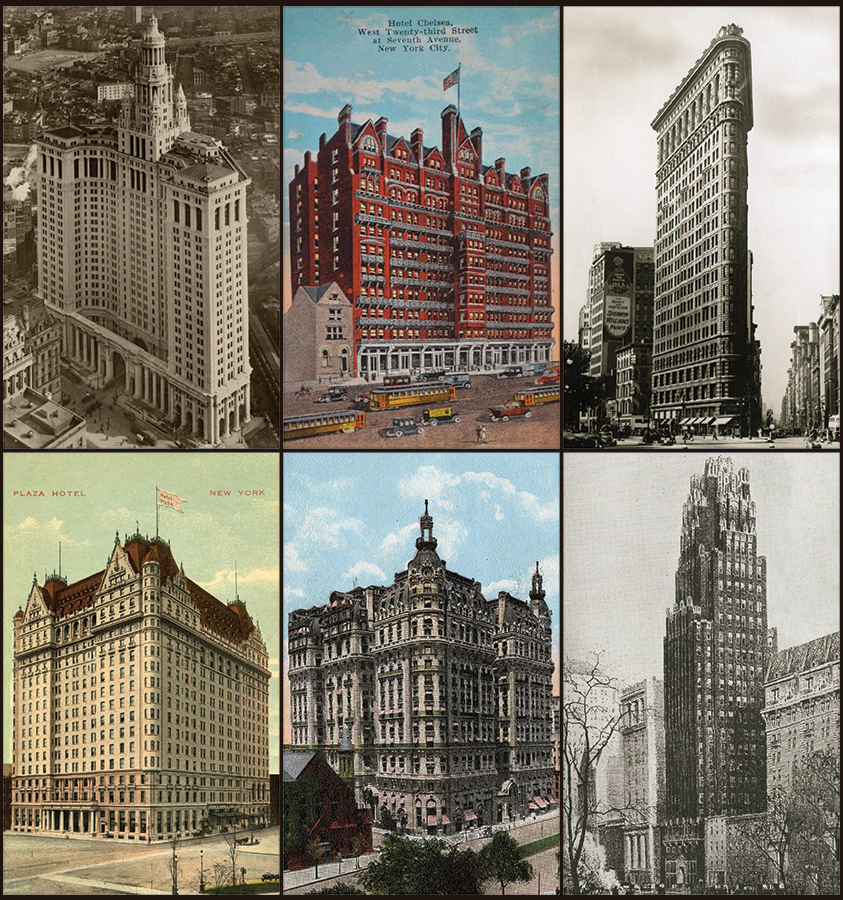
When the new Landmarks Preservation Commission began designating buildings in 1966, it had a list of candidates compiled by the advocates who had pushed for the legislation. Many of those were city-owned properties and thus could be designated without opposition: that explains why the Municipal Building was the first skyscraper protected. Later that year, the Flatiron Building was the first privately-owned skyscraper to be designated, along with three early high-rises that were apartments or hotels. The Woolworth Building was considered at the second public hearing in 1966, but the Commission declined to designate it.
Some extraordinary buildings were lost. In 1969, the Singer Building – tallest in the world when it was completed in 1907 – was demolished to make way for the massive modernist slab of the U.S. Steel Building (One Liberty Plaza). The Commission considered designation, but as then Executive Director of the LPC Alan Burnham explained, “If the building were made a Landmark, we would have to find a buyer for it, or the city would have to acquire it. The city is not that wealthy, and the Commission doesn’t have a big enough staff to be a real-estate broker for a skyscraper.”
The LPC also worried about court challenges to the fundamental constitutionality of the Landmarks Law and was especially anxious about the litigious nature of the real estate industry. In 1967, the Penn Central Railroad sued the City over the designation of Grand Central Terminal – and won. The City appealed, but the legal limbo – which lasted for 12 years, until the U.S. Supreme Court upheld the law on June 26, 1978 – created an unspoken moratorium on designating any skyscrapers. None were proposed from 1969 to 1978, except for the American Radiator Building in 1974.
The American Radiator Building became the second commercial skyscraper to be designated, despite the owner’s objection. The Commission grouped the 1924 office tower in the same hearing with the Interior Landmark of the entrance foyer of the New York Public Library and the Scenic Landmark of Bryant Park – both new categories for the LPC’s protection – to treat them as “an urban ensemble” of aesthetic value.
1975-1981, Art Deco Midtown
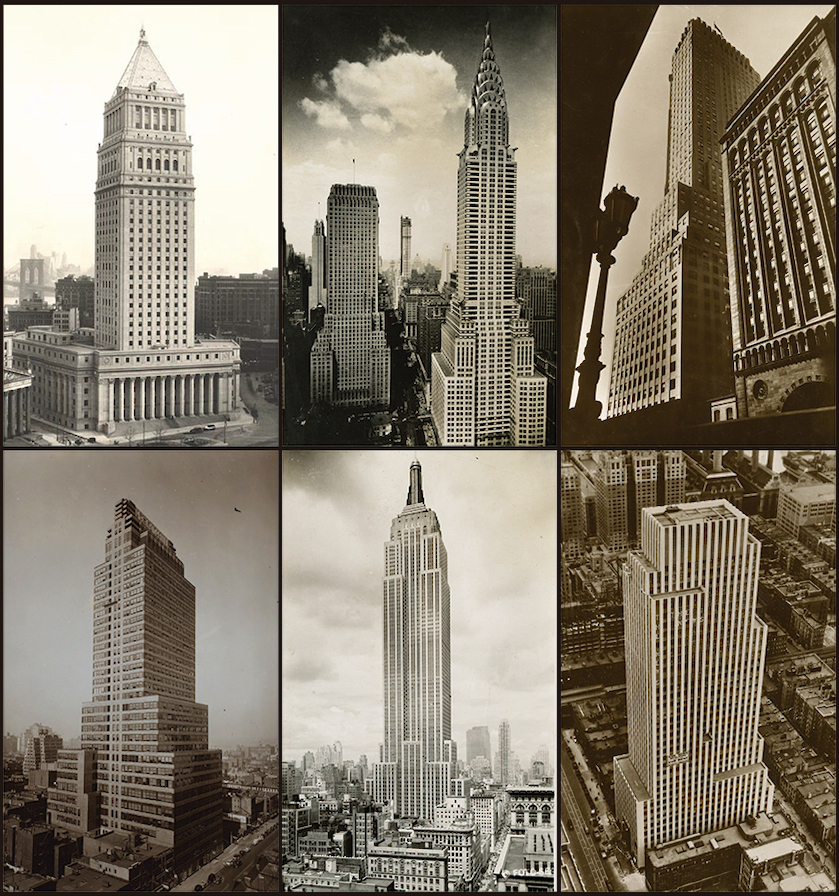
On September 17, 1974, The New York Times published a short editorial, “No Skyscraper Landmark,” that chided the Commission for its failure to designate “precisely those buildings that are not only New York’s most real and famous Landmarks, but also some of the greatest urban Landmarks of the 20th century – the skyscrapers that are synonymous with the city’s life and style.” Mentioning by name the Woolworth Building, Empire State Building, Chrysler Building, and Rockefeller Center, the author concluded: “These strange omissions are a gargantuan oversight.”
The omissions began to be redressed in 1978 – shortly after the Supreme Court upheld the constitutionality of the Landmarks Law – with a spate of skyscrapers in Midtown. From 1978-1981, the Commission designated five Art Deco icons: the Empire State and Chrysler buildings, as well as a chorus line of towers lining 42nd St. including the Daily News, Chanin, and McGraw-Hill buildings. In the mid-1980s Rockefeller Center, General Electric, and the Fred French Building were protected.
The Art Deco style – which from its appearance in architecture in the mid-1920s had been derided by many critics as a sort of impure modernism that was too decorative and popular – began to receive academic study in the early 1970s. Many warmed to the richness of materials, and palette, and the artistry of the designers and crafts persons who fashioned the ornament. The façades and the lobbies, many of which were also designated as Individual Landmarks, expressed an inventive and distinctive aesthetic of “Machine Age” modernism.
With Kent Barwick as the Chair of the LPC from 1978-1983, appointed by the new Koch administration, the Commission had a leader who had been an advocate and activist for preservation. As the head of the Municipal Art Society (MAS) both before and after his tenure in government, Barwick led protests to save Grand Central, the Broadway theaters and Times Square, and a host of other campaigns.
1982-1986, More Midtown and Lever House
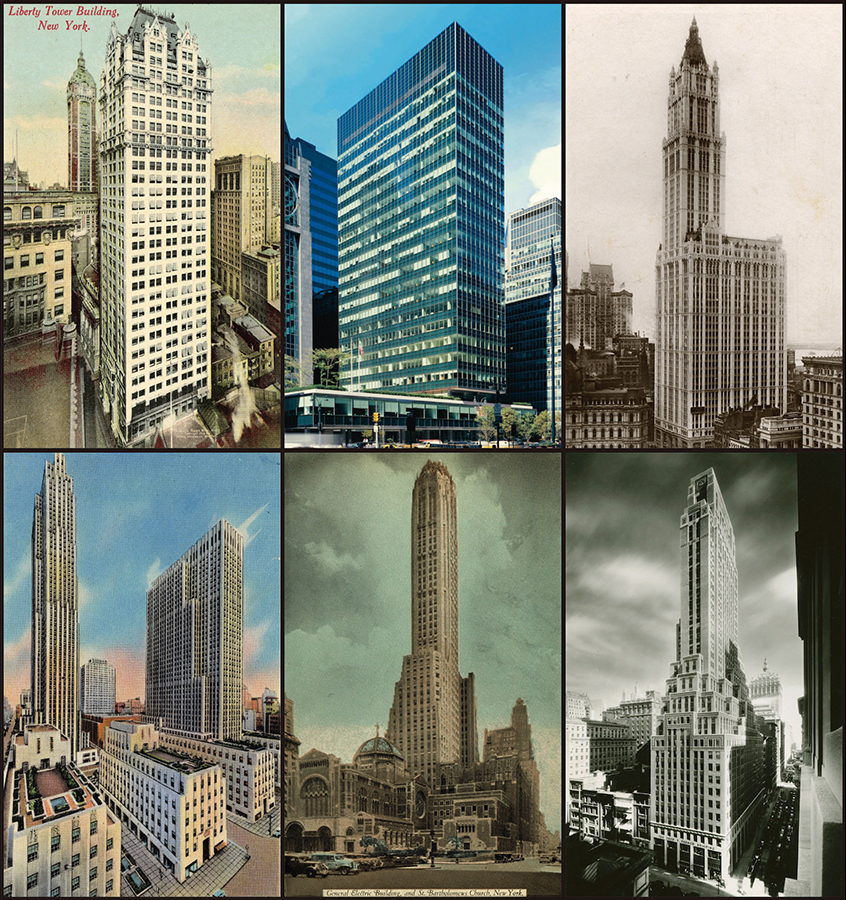
The early Eighties saw a mix of designations under Chairman Kent Barwick that finally checked off some obvious, but recalcitrant candidates, including the Woolworth Building and Rockefeller Center, the LPC also added the first postwar skyscraper to the roster.
In November 1982, the Commission voted unanimously to designate Lever House, the 24-story glass box that in 1952 had introduced a new era and sensibility to Park Avenue, then largely a corridor of stately residential co-ops. As the short skyscraper turned 30, and thus was eligible for protection, the Commission cited it as “among the first, as well as the most famous, corporate expressions of the modern International Style in postwar America.”
But the vote of eleven Commissioners had to be approved by the Board of Estimate, a now-defunct entity replaced by City Council approval. There the designation slammed into both politics and a high stakes Monopoly game of New York real estate. Partial owners of the property, the Fisher Brothers, who preferred to develop a new and larger building on the site, sued to stop the process. Weighing many factors for the future of the city, as well as other pressures, eventually, on January 27, 1983, the Board of Estimate upheld the designation.
The Woolworth Building was designated both an Individual Landmark and Interior Landmark for its lobby on April 12, 1983, seventy years after its 1913 opening as the world’s tallest building. First proposed in 1967, Woolworth received a second hearing in 1970, but the Commission again took no action because the owner opposed designation. A major issue was their objection to LPC oversight over restoring the tower’s elaborate terra-cotta façade. An urgent restoration had been undertaken in 1977 using cast concrete panels, beginning a long history of experiments that continue to today, although now under the review of the LPC.
1985-1988, Upper West Side Art Deco
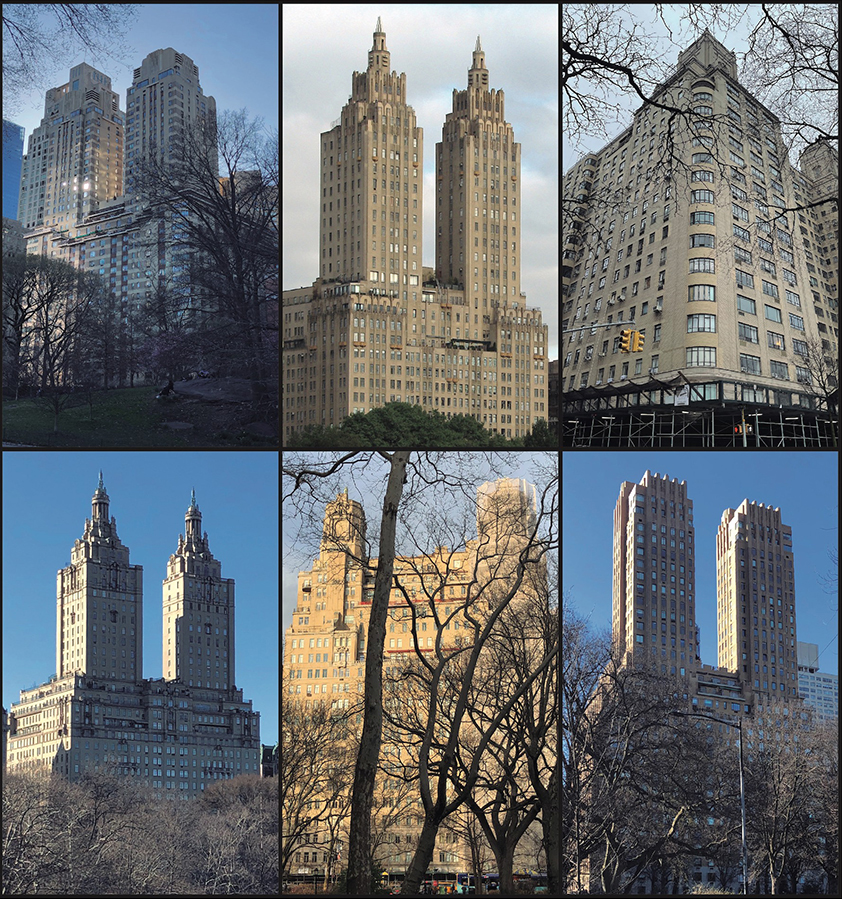
Another LPC initiative of the mid-1980s, under Chair Gene Norman, was the expansive Central Park West and Riverside-West End Historic Districts, which ultimately covered the majority of the Upper West Side and embraced more than 2000 buildings, nearly all residential. Before the Historic Districts were designated, though, a special group of Art Deco apartment buildings – the Century, Eldorado, Normandy, San Remo, Beresford, and Majestic – were made Individual Landmarks.
Unusually, requests for designation came from groups of residents alarmed by the buildings’ plans to destroy the original, leaking casement windows. Their urgent appeals received quick results by the Commission which calendared the buildings and in the case of the Normandy designated the building at its first public hearing – thus requiring any further changes be reviewed by the LPC.
The twin-towered Century, Eldorado, San Remo, and Majestic, as well as the more cliff-like character of the Beresford or Normandy on Riverside Drive, represent a distinctive type of apartment block massing that came into being after the passage of the 1929 Multiple Dwelling Law. Amending the old code that capped residential construction at a maximum height of 150 feet, the new law allowed apartment buildings on large lots sited on 100-foot avenues to rise to 300 feet to become true skyscrapers.
1986-1988, Mostly Midtown
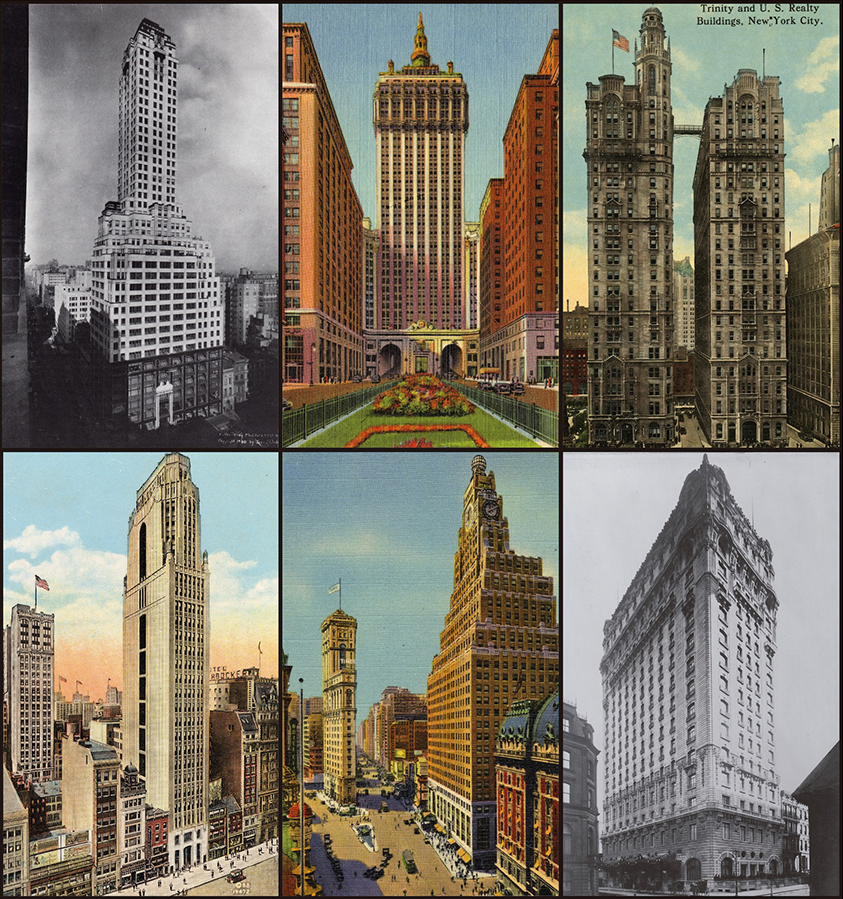
In the later 1980s a miscellaneous list of high-rise designations continued under Gene Norman, the first Chair to serve as a full-time, full-salary Chairman. Norman focused on the operations of the agency, both for its internal processes and its responsiveness in reviewing applications. By 1988, the scope of the regulatory work and the number of properties that needed alterations that required review by the LPC in public hearings was greatly expanded. As The New York Times real estate reporter Alan S. Oser wrote in 1988:
“Landmarking designations, historic-district designations and interior-Landmark designations have blossomed ever since the Supreme Court decision. There were only 400 individually Landmarked buildings 10 years ago. Today there are 800. There were 31 historic districts then. Today there are 52. There are also 76 interior Landmarks today, many of them recently designated in Manhattan’s legitimate theaters.”
The huge Historic Districts encompassing (dozens of) residential blocks on the both the Upper East Side and Upper West Side consumed much of the agency’s energy — especially with mundane issues of new window applications and minor violations.
At the same time, important older buildings and even designated Landmarks were threatened by rampant high-rise development. A major case was the proposal to demolish the community house adjacent to St. Bart’s (St. Bartholomew’s Episcopal Church) on Park Avenue to construct a 60-story speculative office tower. Litigation ensued, but as with the Grand Central case, the court decision ultimately reinforced the power of the Landmarks Commission.
1989-1991, Seagram and the Tilt to Downtown
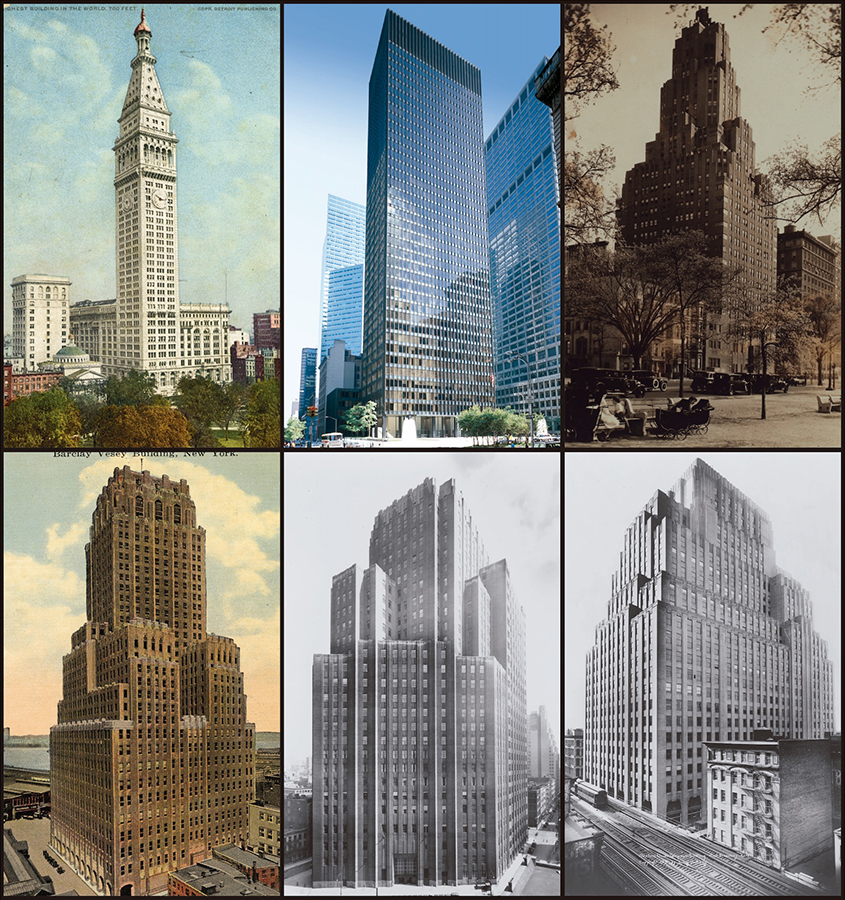
From its completion in 1958, the sublime Seagram Building, designed by the German-born Bauhaus émigré Ludwig Mies van der Rohe, was the skyscraper that epitomized the values of high-brow, high Modernism known as the International Style. It was designated on October 3, 1989, soon after it turned 30 years old and became eligible for Landmarking. Built as the headquarters for the successful Canadian liquor company Seagram, the 38-story tower was a minimalist glass box articulated by spare bronze I-beam mullions and set back from Park Avenue like a temple on a podium base with a plaza forecourt. Seagram’s welcomed the Landmark status and had even proposed its protection to the Commission in 1976.
This group of six also reveals the beginning of the tilt of the LPC’s focus to Downtown designations. The first group was a trio of massive buildings constructed in the 1920s for the telecommunications companies, AT&T and Western Union. They contained both offices and mechanical operations. Designated on the same day, October 1, 1991, under LPC Chair Laurie Beckelman, all three were designed by Ralph Walker, a master of the “setback style” that was shaped by the requirements of the city’s 1916 zoning law.
In particular, the Barclay-Vesey Building, designed in 1924 and completed in 1926, was one of the earliest and most influential in the evolution of what many architects and writers of the day called the “New Architecture.” Eschewing historical styles, Walker emphasized the power of simple, sculptural masses and applied surface ornament in modernistic motifs that today we call Art Deco. On 9/11, the Barclay-Vesey Building, which stood just north of Tower 1 of the World Trade Center, was severely damaged by its collapse. In 2005, a $322 million restoration project was completed. But the building again suffered damages from flooding during Hurricane Sandy in 2012. Over the decades, all three Walker buildings have undergone renovations to modernize their 1920s telecommunications services. In 2016, the Barclay-Vesey Building, also known as 140 West Street, was converted to luxury condominiums on the upper floors and its Landmarked lobby was gloriously restored.
1991-1995, Downtown
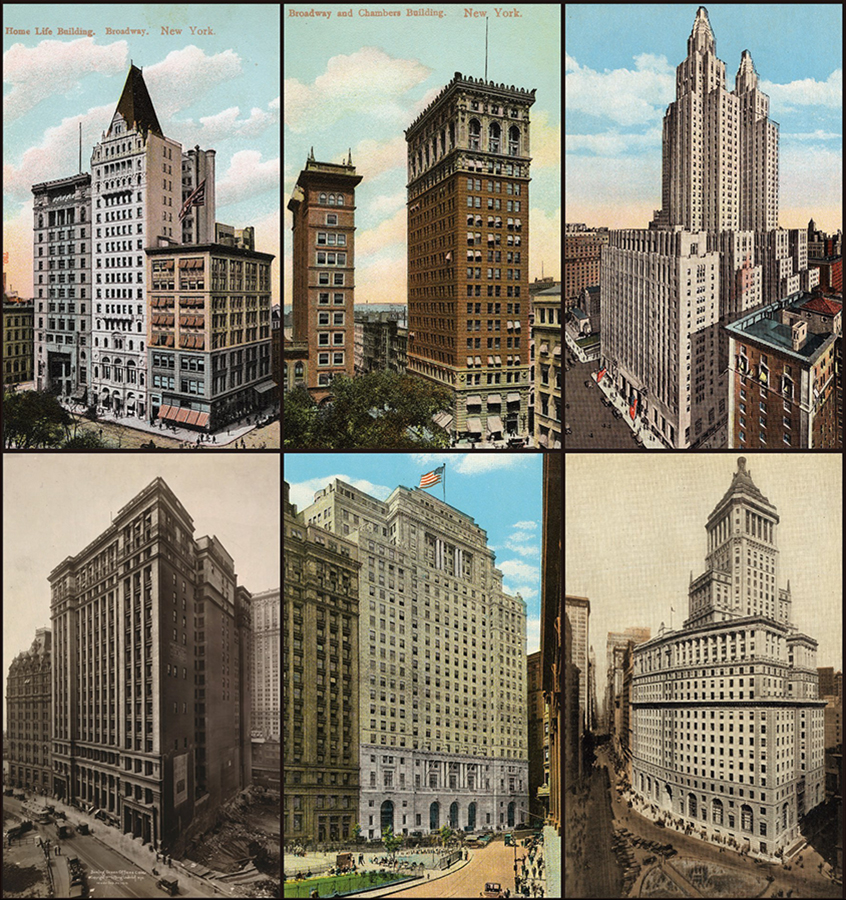
Lower Manhattan became the almost exclusive focus of the Commission’s efforts from 1994 to 2001 under Chair Jennifer Raab, who succeeded Laurie Beckelman as the Chair of the LPC when the Giuliani administration took office in 1994. The LPC designated 24 Individual Landmarks, 17 of which were skyscrapers, as well as the Stone Street Historic District. Building owners in the Financial District had long resisted LPC regulation, which they regarded as a threat to their control over their property and to the potential for turning smaller, older buildings into larger future building sites.
But in the real estate slump of the early-to-mid-1990s, arguments for Landmark designation had a new logic. The impetus to convert Downtown’s older office buildings to residential use began in the mid-1990s for a host of reasons. The stock market crash of 1987 and the savings-and-loan crisis brought a recession to New York commercial real estate markets that by mid-decade had produced a vacancy rate above 30 percent and left 25 million sf. of office space unrented.
The City began to put in place policies that incentivized the restoration and interior upgrades of older office buildings, as well as their conversion to residential use. Buildings that were designated NYC Landmarks or were added to the National Register were further eligible for federal historic preservation tax credits, as well as for City tax breaks. Thus, Landmark designation became an aspect of an economic development strategy and set of policies, as well as a planning tool to transform Downtown into a more vibrant, mixed-use neighborhood with a growing residential population.
1995-1997, More Downtown
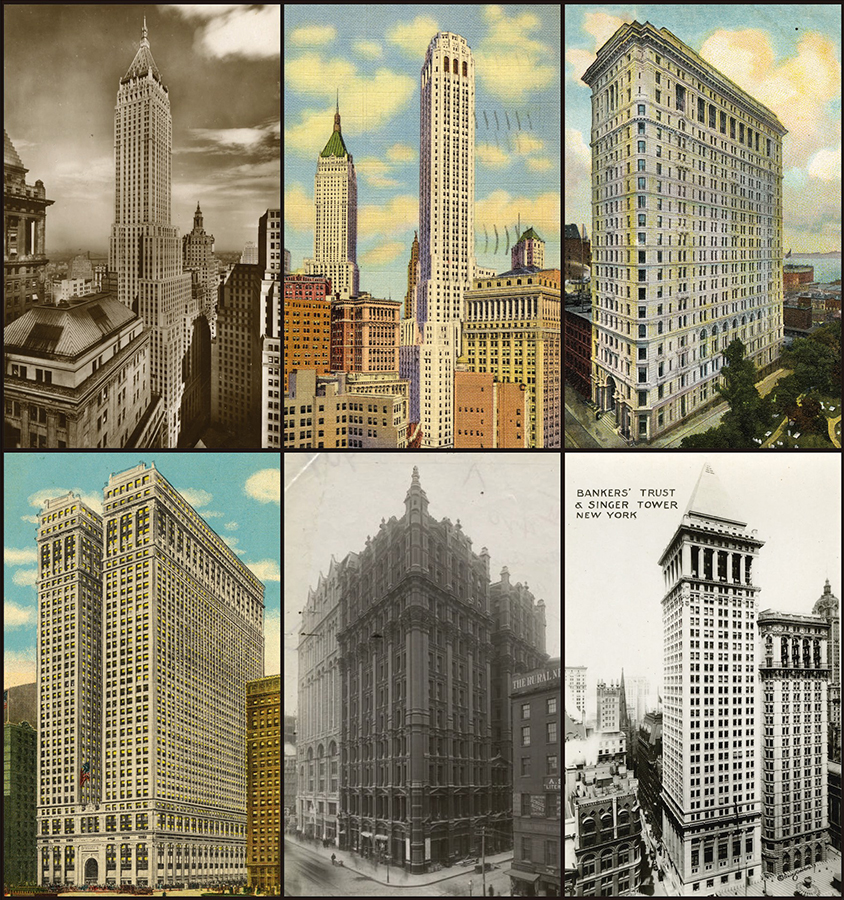
The first of the Downtown designations under Chair Jennifer Raab – a trio of stately office blocks that flanked lower Broadway at Bowling Green – were designated on the same day: September 19, 1995. The headquarters of John D. Rockefeller’s Standard Oil Company at 26 Broadway faced the Cunard Building, the flagship of the transatlantic ocean liner empire. These classically inspired, limestone-clad cliffs shaped the southern end of the urban canyon that stretched north to Wall Street and beyond to City Hall Park. The earliest of the trio, the Bowling Green Building at 5-11 Broadway, was one of the largest office buildings in the city when completed in 1898 and contained some 6,000 tenants. A purely speculative commercial building, it represented the high-rise type of the era before the city’s first zoning law in 1916 required setbacks at upper levels.
Today, these three buildings remain offices by use. When The New York Times reporter David Dunlap wrote “Bringing Downtown Back Up” on Oct. 15, 1995, it was the general assumption that older buildings in the Financial District would be renovated, not converted. Yet, Dunlap added, “Whether visionary or delusional, the possibility is also being explored of converting some distinguished but obsolete office towers into apartment buildings; cliff dwellings and aeries that would appeal to the same pioneering spirit that colonized SoHo and TriBeCa.”
Of the six buildings in this frame, three are still office buildings: 40 Wall St., the Equitable Building at 120 Broadway, and the Bankers Trust Building. The others were converted to apartments – the 57-story City Bank-Farmers Trust, now called 20 Exchange Pl., in phases from 2006-2015, and the Empire Building, just south of Trinity Church, in 1997. An early Park Row high-rise, the ornate 1886 Potter Building, pioneered the transformation of office buildings to lofts when it was converted to cooperative apartments in 1981.
1997-1998, More Downtown and CBS
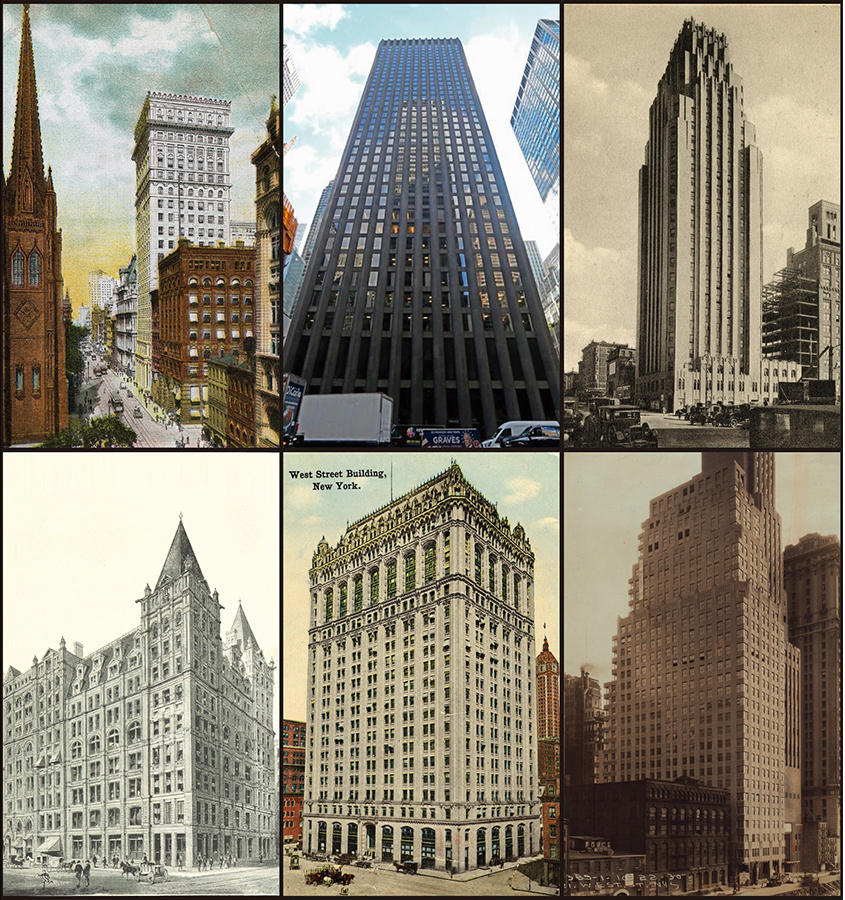
The campaign of Downtown designations continued under Chair Jennifer Raab from 1995 through 2001, with fourteen more skyscrapers added to the roster of Individual Landmarks, as well as, in June 1996, the Stone Street Historic District. Stone Street was a block of modest low-rise, early-19th century commercial buildings that became the focus of a historic preservation project championed by the Business Improvement District, the Downtown Alliance. It also had an economic development goal of bringing restaurants and lively street life to the area of previously derelict buildings.
Notable in this group of six is the West Street Building, a 1907 Gothic terra-cotta tower designed by architect Cass Gilbert before he conceived the Woolworth Building. The structure at 90 West Street, just south of the South Tower of the World Trade Center, remained an office building until September 11, 2001, when it was nearly destroyed by the collapse of Tower 2 and burned from fires inside. In 2005, it was completely restored – including with new ornamental terra-cotta – and converted to rental apartments.
Also, in October 1997, the CBS headquarters, known as Black Rock, followed Lever House and the Seagram Building as the third postwar office building to be designated.
1998-2000, More Downtown
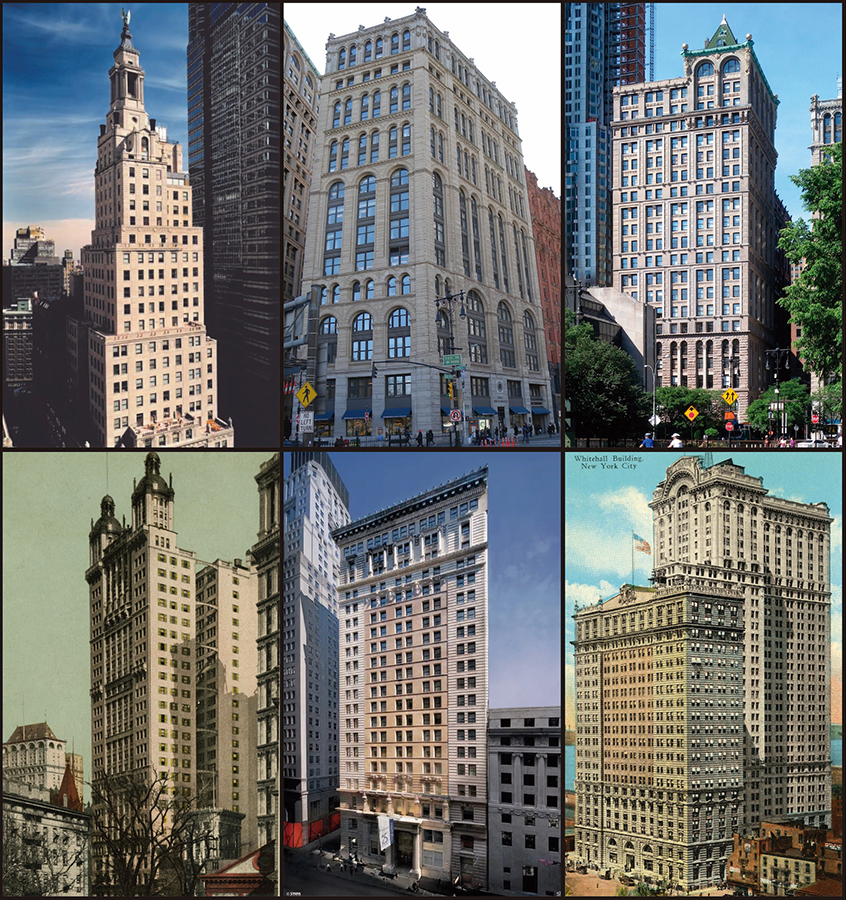
By 2000, the densest concentration of Individual Landmarks in the city (with the exception of the three full blocks of Rockefeller Center) was Downtown, focused especially in the core of the Financial District, lining Broadway, and surrounding City Hall Park.
Of the six buildings in this group, three are early skyscrapers associated with “Newspaper Row,” the moniker of Park Row from the mid-19th century when dozens of dailies and national magazines published and printed their papers in the area. In order of age, they are G.B. Post’s New York Times Building (1889), the American Tract Society Building (1895), and the Park Row Building (1899), which on its completion in 1899 was the world’s tallest office building at 391 feet. While the former New York Times Building has served as classrooms and offices for Pace University since 1951, the other two structures were more recently converted to apartments: the Park Row Building began with the upper floors in 2001, then fully in 2018, and the American Tract Society Building in 2003. Similarly, 25 Broad St. was transformed into rental apartments in 1997, as was the Whitehall Building on Battery Place in 1999.
2000-2002
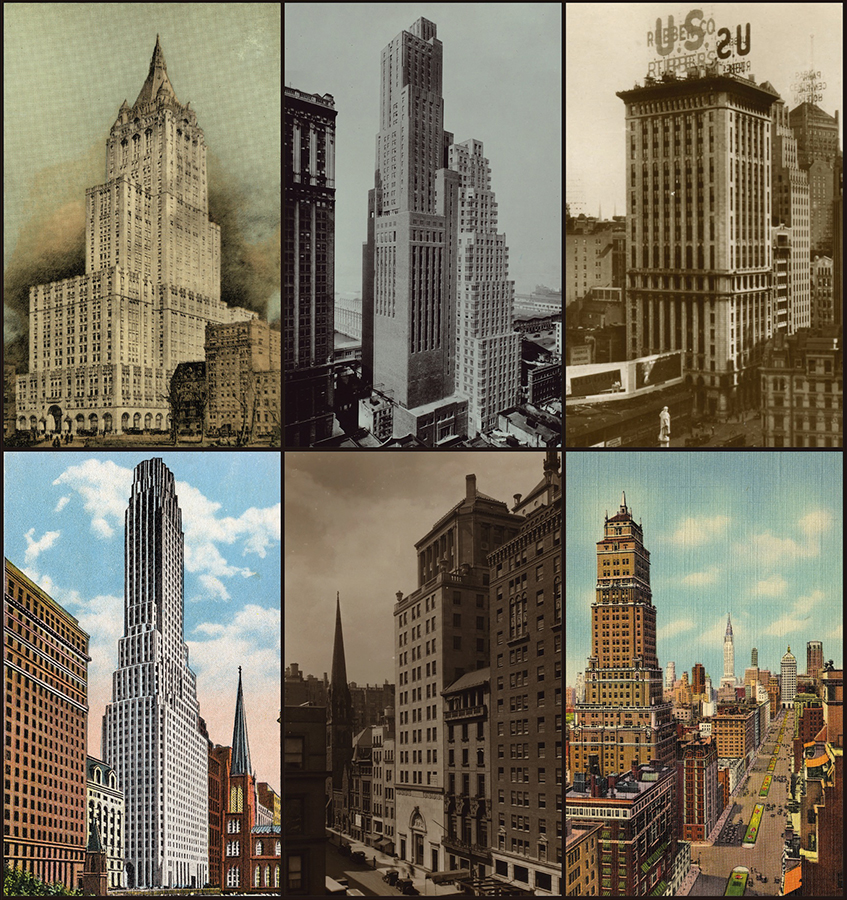
Two more significant Downtown skyscrapers were designated in 2000-2001. One was the Downtown Athletic Club, a restrained red brick Art Deco tower by architects Starrett & Van Vleck, which had housed athletic activities, dining rooms, and residential quarters. The other was 1 Wall Street, the most elegant skyscraper designed by Ralph Walker, originally erected as the headquarters of the Irving Trust Bank.
Between 2000-2002, three Midtown buildings of the Twenties were added to the roster. The New York Life Insurance Building, designed by Cass Gilbert as a Gothic-inspired setback tower and clad in limestone, rather than Woolworth’s terra-cotta, rose over a full block at the northeast corner of Madison Square Park, on the former site of Madison Square Garden. On W. 57th St., the former Steinway Hall was classical and reserved, while the Ritz Tower on E. 57th St. had a chateauesque silhouette that matched the other swank apartment hotels of the period, such as the Sherry Netherland and Pierre.
2003-2009
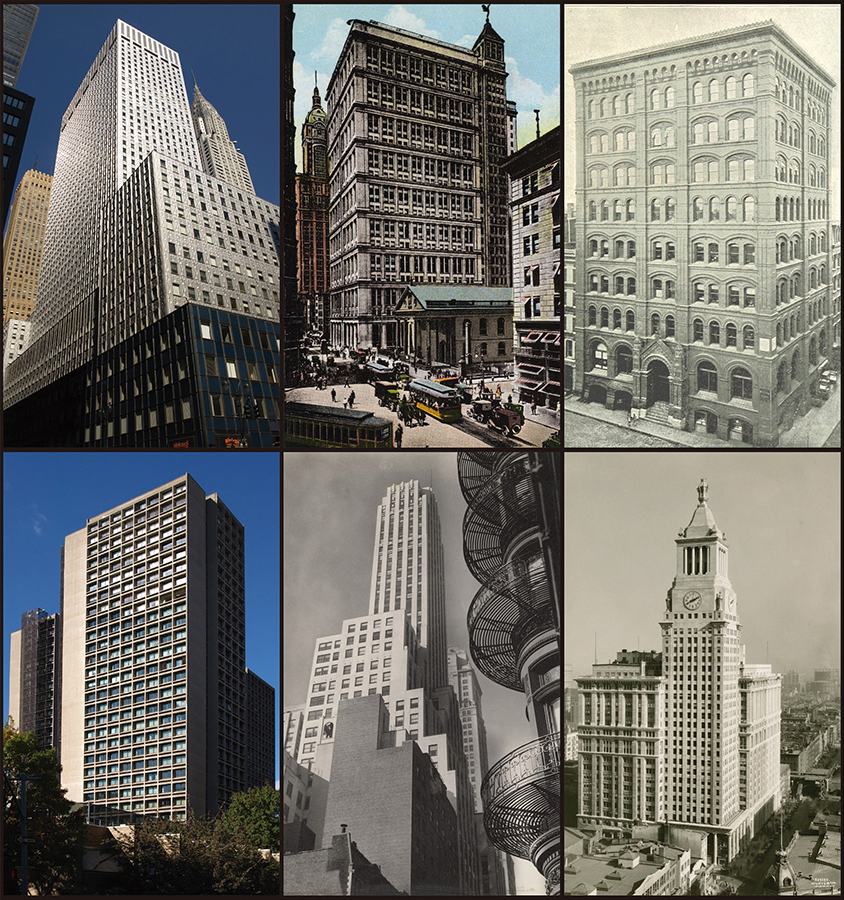
After 9/11 and in 2002 when the Bloomberg administration began its three-term tenure with Robert Tierney as the new Chair, the pace of protection for skyscrapers slowed. Whereas Raab’s LPC had designated twenty-four buildings in seven years, from 2003-2013 only twelve were added. As the next two groups of images illustrate, the tall buildings Landmarked represented an eclectic mix of geography, eras, and styles.
Two postwar projects are notable. The Socony-Mobil Building at the corner of Lexington and 42nd St., completed in 1956, is an oddball skyscraper by Harrison & Abramowitz that features a façade of pleated chromium nickel panels embossed with geometric designs and relatively small window openings in the curtain wall. The second is a trio of apartment blocks known as University Village or Silver Towers, designed by I.M. Pei & Associates and completed in 1967. They were engineered and erected in an innovative system of concrete construction that expressed the raw surface of the material as part of the modernist and minimalist aesthetic.
2009-2016
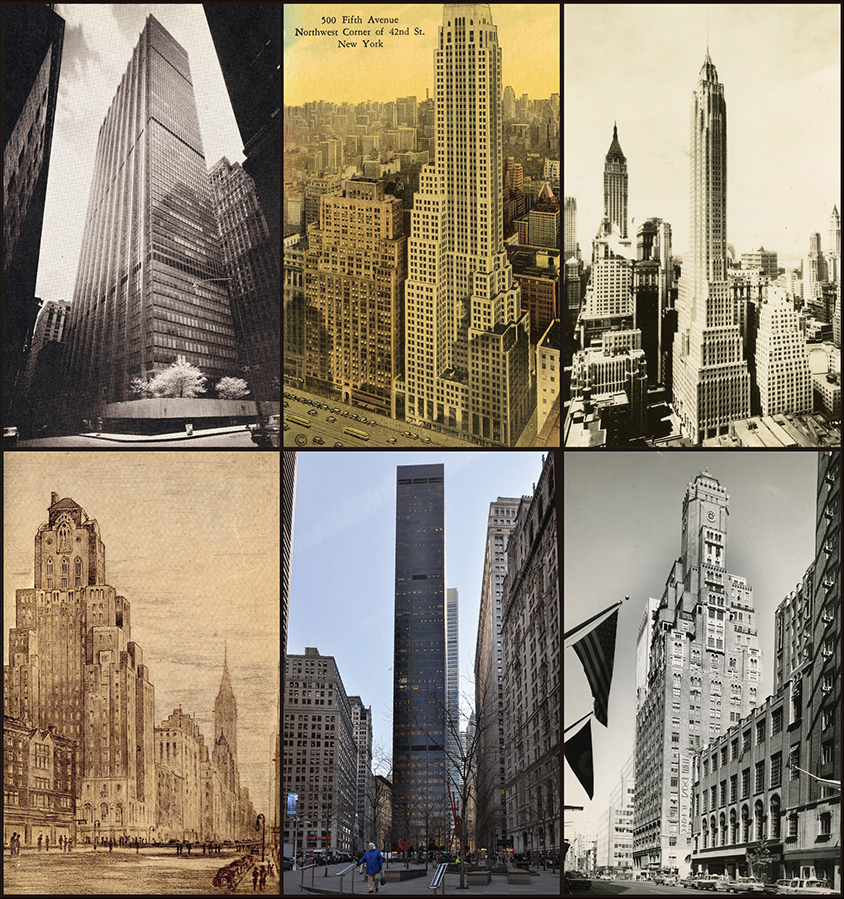
In the third term of the Bloomberg administration from 2009-2013, one skyscraper was designated per year, with a balance between Midtown and Downtown. Two in Lower Manhattan were outstanding postwar office towers, exemplars of International Style Modernism designed by Skidmore, Owings & Merrill (SOM): One Chase Manhattan Plaza, built from 1957-1964, and the Marine Midland Building at 140 Broadway, completed in 1968. The first major office building erected in the Financial District after WWII, One Chase Manhattan Plaza was a key investment by the Bank and its powerful president David Rockefeller, signing a commitment to maintaining its headquarters Downtown. Likewise, the sleek glass-box of the Marine Midland Building — rising as a sheer slab in a large plaza — brought ultra-modern office space to lower Broadway.
The other four skyscrapers in this group were handsome towers of the Twenties, including the Cities Service Building at 70 Pine St., with its sumptuous Art Deco ornament at the street level and in its Landmarked lobby. In Midtown, two residence hotels, the Barbizon Hotel for Women and the Beverly, both from 1927, evidenced the development opportunities around Grand Central Terminal.
2016-2018
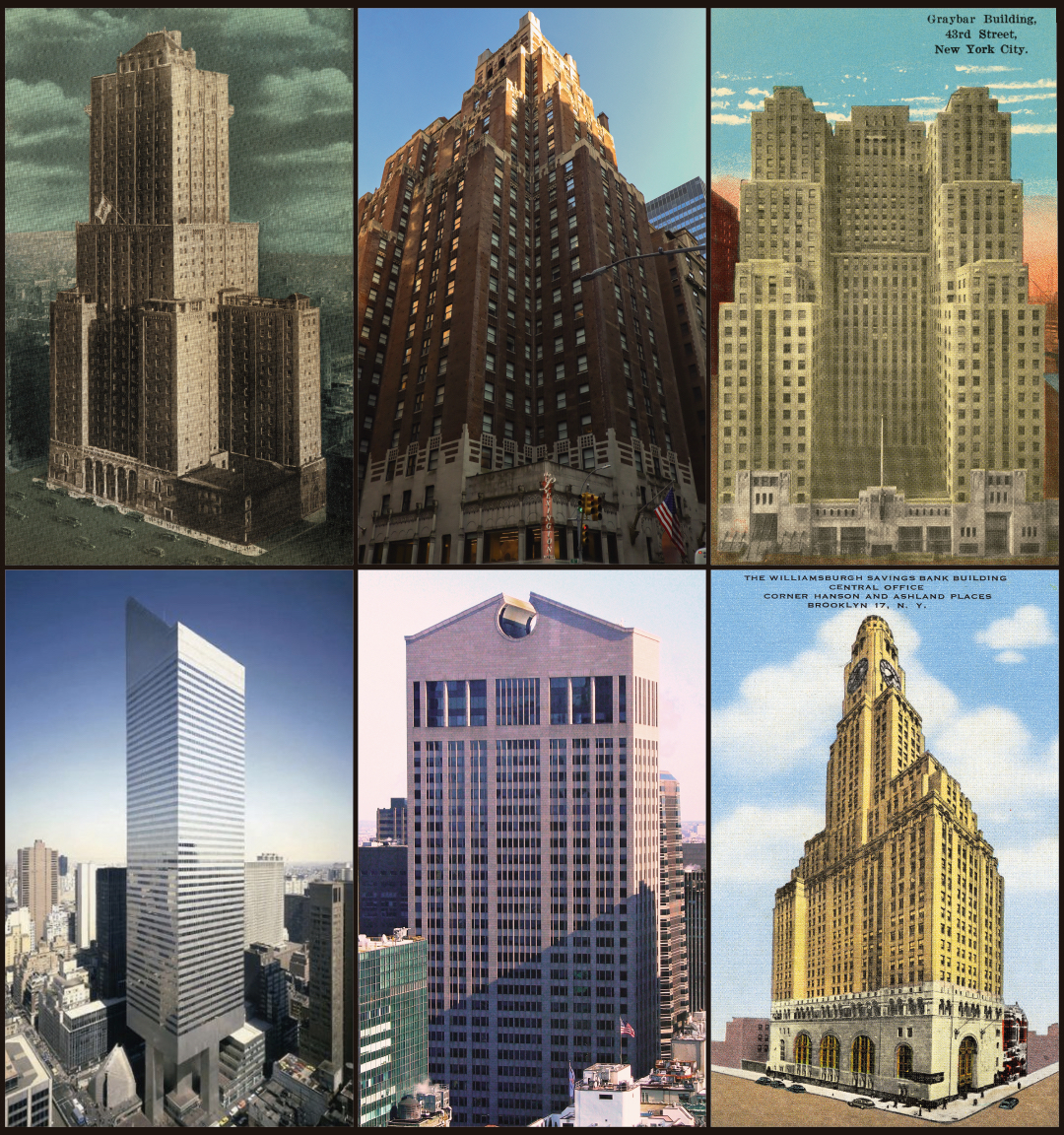
Under the new de Blasio administration in 2014 and a new Chair Meenakshi Srinivasan, the push to upzone the blocks around Grand Central, initiated by City Planning in the last Bloomberg years, was accomplished. The idea was to maintain the competitive advantage of Midtown’s transportation nexus by allowing greater density in new towers than was possible under the old code. The broad planning and economic development goal of East Midtown Rezoning required the collaboration and compromise of many interest groups.
Preservationists leveraged the opportunity to win the designation of five skyscrapers in 2016, which were part of fifteen new Landmarks in the district. These included the Shelton and Lexington hotels and the Graybar Building, as well as the Citicorp Center. Completed in 1978, the sleek white Citicorp had an elegant geometry in its square shaft and slanted top, that affirmed the values of modernism. By contrast, the AT&T Building at 550 Madison, completed in 1984, was intended to shock. Architect Philip Johnson divided the critics with his design for “the first Postmodern skyscraper.” In 2018, after an activist campaign, the building, now called by its address 550 Madison, was designated. The final image in the group is the Williamsburgh Savings Tower in Brooklyn, designated in 1977, which fills out the frame and points to a group of high-rises in Brooklyn Downtown that are protected as part of a Historic District, but are not Individual Landmarks.
1966-1974, Early Landmarks
1
Municipal Building, 1909-1914
1 Centre St.
Architect: McKim, Mead & White
Designation: February 1, 1966
2
Hotel Chelsea, 1883-1885
222 West 23rd St.
Architect: Hubert, Pirsson & Co.
Designation: March 15, 1966
3
Flatiron Building, 1902-1903
175 Fifth Ave.
Architect: D. H. Burnham & Co.
Designation: September 20, 1966
4
Plaza Hotel, 1905-1907
768 Fifth Ave.
Architect: Henry Hardenbergh
Designation: December 9, 1969
5
Ansonia Hotel, 1899-1904
2101-2119 Broadway
Architect: Paul E. M. DuBoy
Designation: March 14, 1972
6
American Radiator Bldg, 1923-1924
40 West 40th St.
Architect: Raymond M. Hood
Designation: November 12, 1974
1975-1981, Art Deco Midtown
7
U.S. Courthouse, 1933-1936
40 Centre St.
Architect: Cass W. Gilbert
Designation: March 25, 1975
8
Chrysler Building, 1928-1930
405 Lexington Ave.
Architect: William Van Alen
Designation: September 12, 1978
9
Chanin Building, 1927-1929
122 East 42nd St.
Architect: Sloan & Robertson
Designation: November 14, 1978
10
McGraw-Hill Building, 1930-1931
330 West 42nd St.
Hood, Godley & Fouilhoux
Designation: September 11, 1979
11
Empire State Building, 1929-1931
20 West 34th St.
Architect: Shreve, Lamb & Harmon
Designation: May 19, 1981
12
Daily News Building, 1929-1930
220 East 42nd St.
Architect: Raymond M. Hood
Designation: July 28, 1981
1982-1986, Midtown & Lever House
13
Liberty Tower, 1909-1910
55 Liberty St.
Architect: Henry Ives Cobb
Designation: August 24, 1982
14
Lever House, 1950-1952
390 Park Ave.
Architect: SOM
Designation: November 9, 1982
15
Woolworth Building, 1911-1913
233 Broadway
Architect: Cass W. Gilbert
Designation: April 12, 1983
16
Rockefeller Center, 1932-33
RCA Bldg, 30 Rockefeller Plaza
Assoc. Arch. of Rockefeller Cntr
Designation: April 23, 1985
17
General Electric Building, 1929-1931
570 Lexington Ave.
Architect: Cross & Cross
Designation: July 9, 1985
18
Fred F. French Building, 1926-1927
551 Fifth Ave.
H. D. Ives, Sloan & Robertson
Designation: March 18, 1986
1985-1988, Upper West Side Art Deco
19
Century Apartments, 1931
25 Central Park West
Architect: Irwin S. Chanin
Designation: July 9, 1985
20
Eldorado Apartments, 1929-1931
300 Central Park West
Architect: Margon & Holder w/ E. Roth
Designation: July 9, 1985
21
Normandy Apartments, 1938-1939
140 Riverside Drive
Architect: Emery Roth & Sons
Designation: November 12, 1985
22
San Remo Apartments, 1929-1930
145-146 Central Park West
Architect: Emery Roth
Designation: March 31, 1987
23
Beresford Apartments, 1928-1929
211 Central Park West
Architect: Emery Roth
Designation: September 15, 1987
24
Majestic Apartments, 1930-1931
115 Central Park West
Architect: Irwin S. Chanin
Designation: March 8, 1988
1986-1988, Mostly Midtown
25
Fuller Building, 1928-1929
595 Madison Ave.
Architect: Walker & Gillette
Designation: March 18, 1986
26
New York Central Bldg, 1927-1929
230 Park Ave.
Architect: Warren & Wetmore
Designation: March 31, 1987
27
111 & 115 Broadway, 1905 & 1907
111 & 115 Broadway
Architect: Francis Hatch Kimball
Designation: June 7, 1988
28
Bush Tower, 1916-1918
130 West 42nd St.
Architect: Helmle & Corbett
Designation: October 18, 1988
29
Paramount Building, 1926-1927
1501 Broadway
Architect: Rapp & Rapp
Designation: November 1, 1988
30
St. Regis Hotel, 1901-1904
2 East 55th St.
Arch.: Trowbridge & Livingston
Designation: November 1, 1988
1989-1991, Seagram & Downtown
31
Metropolitan Life Ins. Co, 1907-9
1 Madison Ave.
Arch.: Napoleon LeBrun & Sons
Designation: June 13, 1989
32
Seagram Building, 1955-1958
375 Park Ave.
Architect: Mies w/ Philip Johnson
Designation: October 3, 1989
33
Master Building, 1928-1929
310 Riverside Dr.
Architect: Harvey Wiley Corbett
Designation: December 5, 1989
34
Barclay-Vesey Building, 1923-27
140 West St.
Architect: Ralph Walker
Designation: October 1, 1991
35
Long Distance Bldg, 1930-31
32 Sixth Ave.
Architect: Ralph Walker
Designation: October 1, 1991
36
Western Union Bldg, 1928-30
60 Hudson St.
Architect: Ralph Walker
Designation: October 1, 1991
1991-1995, Downtown
37
Home Life Building, 1892-1894
253-257 Broadway
Arch.: G. E. Harding and Gooch
Designation: November 12, 1991
38
Bway-Chambers Bldg, 1899-1900
277 Broadway
Architect: Cass W. Gilbert
Designation: January 14, 1992
39
Waldorf-Astoria Hotel, 1929-1931
301 Park Ave.
Architect: Schultze & Weaver
Designation: January 5, 1993
40
Bowling Green Off. Bldg, 1895-98
5-11 Broadway
Architect: W. & G. Audsley
Designation: September 19, 1995
41
Cunard Building, 1920-1921
25 Broadway
Architect: Benjamin Wistar Morris
Designation: September 19, 1995
42
Standard Oil Building, 1921-1928
26 Broadway
Architect: Carrère & Hastings
Designation: September 19, 1995
1995-1997, More Downtown
43
Manhattan Co. Bldg, 1929-1930
40 Wall St.
Architect: H. Craig Severance
Designation: December 12, 1995
44
City Bank-Farmers Trust, 1930-31
20 Exchange Pl.
Architect: Cross & Cross
Designation: June 25, 1996
45
Empire Building, 1897-1898
71 Broadway
Arch.: Kimball & Thompson
Designation: June 25, 1996
46
Equitable Building, 1913-1915
120 Broadway
Arch.: Graham w/ Anderson
Designation: June 25, 1996
47
Potter Building, 1883-1886
35 Park Row
Arch.: N. G. Starkweather
Designation: September 17, 1996
48
Bankers Trust, 1910-1912
14 Wall St.
Arch.: Trowbridge & Livingston
Designation: January 14, 1997
1997-1998, Downtown & CBS
49
American Surety Bldg, 1894-1896
100 Broadway
Architect: Bruce Price
Designation: June 24, 1997
50
CBS Building, 1961-1964
Sixth Ave., 52nd St. to 53rd St.
Architect: E. Saarinen & Assoc.
Designation: October 21, 1997
51
Panhellenic Tower,1927-1929
First Ave. & 49th St.
Architect: John Mead Howells
Designation: February 3, 1998
52
Temple Court Building, 1881-1883
3-9 Beekman St.
Architect: Silliman & Farnsworth
Designation: February 10th, 1998
53
West Street Building, 1905-1907
90 West St.
Architect: Cass W. Gilbert
Designation: May 19, 1998
54
21 West Street Bldg, 1929-1931
21 West St.
Architect: Starrett & Van Vleck
Designation: June 16, 1998
1998-2000, More Downtown
55
Bank of NY & Trust Bldg, 1929-31
48 Wall St.
Architect: Benjamin Wistar Morris
Designation: October 13, 1998
56
New York Times Bldg, 1888-1889
41 Park Row
Architect: George B. Post
Designation: March 16, 1999
57
American Tract Soc. Bldg, 1894-95
150 Nassau St.
Architect: R. H. Robertson
Designation: June 15, 1999
58
Park Row Building, 1896-1899
15 Park Row
Architect: R. H. Robertson
Designation: June 15, 1999
59
Broad Exchange Bldg, 1900-1902
25 Broad St.
Architect: Clinton & Russell
Designation: June 27, 2000
60
Whitehall Building, 1902-1904
17 Battery Pl.
Architect: Henry J. Hardenbergh
Designation: October 17, 2000
2000-2002
61
NY Life Insurance Co., 1926-1928
51 Madison Ave.
Architect: Cass W. Gilbert
Designation: October 24, 2000
62
Downtown Athletic Club, 1929-30
20 West St.
Architect: Starrett & Van Vleck
Designation: November 14, 2000
63
U.S. Rubber Co. Bldg, 1911-1912
1790 Broadway
Architect: Carrère & Hastings
Designation: December 19, 2000
64
Irving Trust/Bank of NY, 1929-31
1 Wall St.
Architect: Ralph Walker
Designation: March 6, 2001
65
Steinway Hall, 1924-1925
111 West 57th St.
Architect: Warren & Wetmore
Designation: November 13, 2001
66
Ritz Tower, 1925-1927
465 Park Ave.
Architect: E. Roth w/ T. Hastings
Designation: October 29, 2002
2003-2009
67
Socony-Mobil Building, 1954-1956
150 East 42nd St.
Harrison & Abramowitz w/ Peterkin
Designation: February 25, 2003
68
AT&T Building, 1912-1916
195 Broadway
Arch.: William Welles Bosworth
Designation: July 25, 2006
69
Morse Building, 1878-1880
138 Nassau St.
Arch.: Silliman & Farnsworth
Designation: September 19, 2006
70
University Village, 1964-1967
110 Bleecker St.
Architect: I.M. Pei & Assoc.
Designation: November 18, 2008
71
275 Madison Ave. Bldg, 1930-1931
275 Madison Ave.
Architect: Kenneth Franzheim
Designation: January 13, 2009
72
Con. Edison Building, 1910-1911
4 Irving Pl.
Architect: Henry J. Hardenbergh
Designation: February 10, 2009
2009-2016
73
1 Chase Manhattan Plz, 1957-1964
28 Liberty St.
Architect: SOM
Designation: February 10, 2009
74
500 Fifth Ave. Building, 1929-1931
500 Fifth Ave.
Arch.: Shreve, Lamb & Harmon
December 14, 2010
75
Cities Service Building, 1930-1932
70 Pine St.
Clinton & Russell, Holton & George
Designation: June 21, 2011
76
Barbizon Hotel for Women, 1927-28
140 East 63rd St.
Architect: Murgatroyd & Ogden
Designation: April 17, 2012
77
Marine Midland Bldg, 1964-1968
140 Broadway
Architect: SOM
Designation: June 25th, 2013
78
Beverly Hotel, 1926-1927
125 East 50th St.
Architect: Emery Roth
Designation: November 22, 2016
2016-2018
79
Shelton Hotel, 1922-1923
525 Lexington Ave.
Architect: Arthur Loomis Harmon
Designation: November 22, 2016
80
Hotel Lexington, 1928-1929
511 Lexington Ave.
Architect: Schultze & Weaver
Designation: November 22, 2016
81
Graybar Building, 1925-1927
420 Lexington Ave.
Architect: Sloan & Robertson
Designation: November 22, 2016
82
Citicorp Center, 1973-1978
601 Lexington Ave.
Hugh A. Stubbins w/ E. Roth & Sons
Designation: December 6, 2016
83
AT&T Building, 1978-1984
550 Madison Ave.
Architect: P. Johnson & J. Burgee
Designation: July 31, 2018
84
Williamsburgh Savings, 1927-28
1 Hanson Place, Brooklyn
Halsey, McCormack & Helmer
Designation: November 15, 1977
